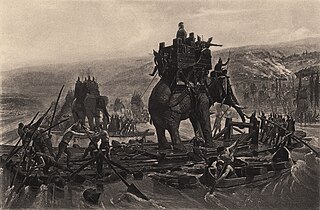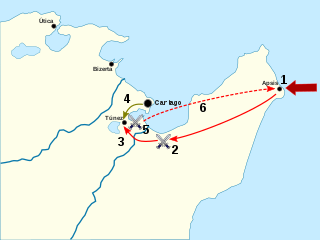Related Research Articles

The 3rd century BC started the first day of 300 BC and ended the last day of 201 BC. It is considered part of the Classical Era, epoch, or historical period.
Year 256 BC was a year of the pre-Julian Roman calendar. At the time it was known as the Year of the Consulship of Longus and Caedicius/Regulus. The denomination 256 BC for this year has been used since the early medieval period, when the Anno Domini calendar era became the prevalent method in Europe for naming years.
This article concerns the period 229 BC – 220 BC.

This article concerns the 200 BC decade, that lasted from 209 BC to 200 BC.
This article concerns the period 159 BC – 150 BC.
This article concerns the period 279 BC – 270 BC.
This article concerns the period 269 BC – 260 BC.
This article concerns the period 259 BC – 250 BC.
This article concerns the period 249 BC – 240 BC.
This article concerns the period 239 BC – 230 BC.
This article concerns the period 219 BC – 210 BC.

Year 250 BC was a year of the pre-Julian Roman calendar. At the time it was known as the Year of the Consulship of Regulus and Longus. The denomination 250 BC for this year has been used since the early medieval period, when the Anno Domini calendar era became the prevalent method in Europe for naming years.
Year 239 BC was a year of the pre-Julian Roman calendar. At the time it was known as the Year of the Consulship of Turrinus and Falto. The denomination 239 BC for this year has been used since the early medieval period, when the Anno Domini calendar era became the prevalent method in Europe for naming years.
Xanthippusof Lacedaemon, or of Carthage, was a Spartan mercenary general employed by Carthage during the First Punic War. He led the Carthaginian army to considerable success against the Roman Republic during the course of the war, training the army to a professional standard before defeating the Romans at the Battle of Tunis, where Carthaginian forces routed the Roman expeditionary force and captured the Roman consul Marcus Atilius Regulus in 255 BC.

The Battle of the Bagradas River, also known as the Battle of Tunis, was a victory by a Carthaginian army led by Xanthippus over a Roman army led by Marcus Atilius Regulus in the spring of 255 BC, nine years into the First Punic War. The previous year, the newly constructed Roman navy established naval superiority over Carthage. The Romans used this advantage to invade Carthage's homeland, which roughly aligned with modern-day Tunisia in North Africa. After landing on the Cape Bon Peninsula and conducting a successful campaign, the fleet returned to Sicily, leaving Regulus with 15,500 men to hold the lodgement in Africa over the winter.

The battle of Adys took place in late 256 BC during the First Punic War between a Carthaginian army jointly commanded by Bostar, Hamilcar and Hasdrubal and a Roman army led by Marcus Atilius Regulus. Earlier in the year, the new Roman navy had established naval superiority and used this advantage to invade the Carthaginian homeland, which roughly aligned with modern Tunisia in North Africa. After landing on the Cape Bon Peninsula and conducting a successful campaign, the fleet returned to Sicily, leaving Regulus with 15,500 men to hold the lodgement in Africa over the winter.

Marcus Atilius Regulus was a Roman statesman and general who was a consul of the Roman Republic in 267 BC and 256 BC. Much of his career was spent fighting the Carthaginians during the first Punic War. In 256 BC, he and Lucius Manlius Vulso Longus defeated the Carthaginians at the naval battle off Cape Ecnomus; afterwards he led the Roman expedition to Africa but was defeated at the Bagradas River in spring of 255 BC. He was captured and then probably died of natural causes, with the story of his death later being much embellished.
Hamilcar was a general who succeeded to the command of the Carthaginians in the First Punic War. He defeated Rome's allies at the Battle of Thermae in 259 BC and killed 4,000–6,000 of them with the help of surprise and good use of military intelligence. He then captured the towns of Enna and Camarina that same year with the assistance of traitors. He was defeated at the Battle of Tyndaris in 257 BC, losing 18 ships and sinking 9 Roman ships. He failed to prevent the Roman landing in Africa, being defeated at the Ecnomus in 256 BC, one of the largest naval battles in antiquity, with the loss of 94 ships, to the Romans' 24. After the Roman invasion of Africa, Hamilcar was recalled by Carthage from Sicily. He was defeated by Marcus Atilius Regulus at the Battle of Adys in 255 BC.
The Roman withdrawal from Africa was the attempt by the Roman Republic in 255 BC to rescue the survivors of their defeated expeditionary force to Carthaginian Africa during the First Punic War. A large fleet commanded by Servius Fulvius Paetinus Nobilior and Marcus Aemilius Paullus successfully evacuated the survivors after defeating an intercepting Carthaginian fleet, but was struck by a storm while returning, losing most of its ships.
Hasdrubal was a Carthaginian general who served during the middle years of the First Punic War, fought between Carthage and Rome, and took a leading part in three of the four major field battles of the war. He was a citizen of the city state of Carthage, which was in what is now Tunisia. His date of birth and age at death are both unknown, as are his activities prior to his coming to prominence in 255 BC. Modern historians distinguish him from other Carthaginians named Hasdrubal by the cognomen "son of Hanno".
References
- ↑ LLC, Arcadian Venture. "First Punic War | Battle of Adys". Arcadian Venture LLC. Retrieved December 1, 2022.
- ↑ "Battle of Tunis, 255 BC". www.historyofwar.org. Retrieved December 1, 2022.
- ↑ "Second Syrian War, 260-255 BC". www.historyofwar.org. Retrieved December 1, 2022.
- ↑ Ramirez-Faria, Carlos (2007). Concise Encyclopedia of World History. Atlantic Publishers & Dist. p. 64. ISBN 978-81-269-0775-5.
Bactria was sheared of by Diodotus, a Greek viceroy, from the post-Alexandrian Seleucid Empire in 256 BCE.
- ↑ Schinz, Alfred (1996). The Magic Square: Cities in Ancient China (2nd ed.). Stuttgart, London: Deahan Printing & Publishing Co.